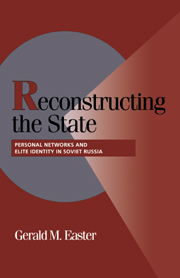Book contents
- Frontmatter
- Contents
- Preface
- 1 Introduction: Explaining State-Building Outcomes and the Soviet Russian Case
- Part I Structure and Identity in the Postrevolutionary State Elite
- Part II Informal Sources of Power in the Postrevolutionary State
- Part III Intrastate Conflict and the Constraints of Power Redefined
- Notes
- Bibliography
- Index
- Titles in the series
1 - Introduction: Explaining State-Building Outcomes and the Soviet Russian Case
Published online by Cambridge University Press: 13 October 2009
- Frontmatter
- Contents
- Preface
- 1 Introduction: Explaining State-Building Outcomes and the Soviet Russian Case
- Part I Structure and Identity in the Postrevolutionary State Elite
- Part II Informal Sources of Power in the Postrevolutionary State
- Part III Intrastate Conflict and the Constraints of Power Redefined
- Notes
- Bibliography
- Index
- Titles in the series
Summary
Throughout the twentieth century, the Soviet Russian state was most often depicted in the West as a modern Leviathan: omnipotent, imposing, and menacing. Yet by the end of the century, this once most feared member of the world community of states had ceased to exist. In its final months, the internal weaknesses of the Soviet Russian state were exposed in a succession of dramatic events: the unraveling of the communist bloc in Eastern Europe, the inept displays of force in the non-Russian national republics, and, finally, the botched palace coup in the capital. In the end, the Soviet Russian state proved incapable of averting its own territorial demise and quietly passed into history with the stroke of a pen.
Among Western scholars, the Soviet Russian state, if not the Leviathan, was certainly assumed to possess sufficient strength to endure well into the twenty-first century. For comparative theorists, Soviet Russia had long stood as a paradigm of successful state building. Leading theorists from both the modernizationist and the statist approaches would concur that, while the means employed were undeniably harsh, the end product was a state that had effectively realized its capacity to rule. Russian area specialists, meanwhile, reinforced this image through their many accounts of the seemingly boundless capabilities of the state to employ coercion, to mobilize resources, and to recast society.
- Type
- Chapter
- Information
- Reconstructing the StatePersonal Networks and Elite Identity in Soviet Russia, pp. 1 - 22Publisher: Cambridge University PressPrint publication year: 2000

